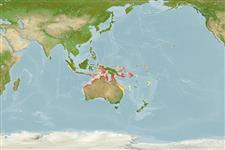>
Ovalentaria/misc (Various families in series Ovalentaria) >
Opistognathidae (Jawfishes)
Etymology: Opistognathus: Greek, opisthe = behind + Greek, gnathos = jaw (Ref. 45335); to the very elongate upper jaw of the type species of the genus, Opistognathus nigromarginatus (Ref. 128653).
More on author: Macleay.
Environment: milieu / climate zone / depth range / distribution range
Ecologia
marinhas associadas(os) a recifes; intervalo de profundidade 1 - 4 m (Ref. 128653). Tropical
Indo-West Pacific: northern Australia.
Tamanho / Peso / Idade
Maturity: Lm ? range ? - ? cm
Max length : 50.0 cm TL macho/indeterminado; (Ref. 36661)
Descrição suscinta
Chaves de identificação | Morfologia | Morfometria
Espinhos dorsais (total) : 10 - 11; Raios dorsais (total) : 17 - 18; Espinhos anais: 2; Raios anais : 14 - 15; Vértebras: 30 - 32. This species is distinguished by the following characters: with a rigid upper jaw lacking flexible lamina posteriorly, in adults extending about 0.7-1.2 eye diameters behind posterior margin of orbit; infraorbitals are relatively slender and tubular, the third infraorbital with small sensory canal opening and slender suborbital shelf; D X-XI,17-18, rarely X,18; vertebrae typically 12 + 18 or 19; body with two separate lateral lines, with the ventral one irregularly developed along lower side in region of anal-fin origin, often with one or more branches on belly; head covered with close-set, tiny, brown spots; pelvic and caudal fins usually strongly barred; anterior naris palmate (Ref. 128653).
Found in shallow reefs, in sand or rubble areas. Mouthbrooders (Ref. 240).
Ciclo de vida ou comportamento de acasalamento
Maturities | Reprodução | Spawnings | Egg(s) | Fecundities | Larvas
Employ mouthbrooding to care for their young (Ref. 240).
Smith-Vaniz, W.F., 2023. Review of Indo-West Pacific jawfishes (Opistognathus: Opistognathidae), with descriptions of 18 new species. Zootaxa 5252(1):1-180. (Ref. 128653)
Status na Lista Vermelha da UICN (Ref. 130435)
Ameaça para os humanos
Harmless
Uso pelos humanos
Ferramentas
Relatórios especiais
Baixar XML
Fontes da internet
Estimates based on models
Preferred temperature (Ref.
123201): 25 - 29.2, mean 28 °C (based on 518 cells).
Índice de diversidade filogenética (Ref.
82804): PD
50 = 0.5000 [Uniqueness, from 0.5 = low to 2.0 = high].
Bayesian length-weight: a=0.00389 (0.00180 - 0.00842), b=3.12 (2.94 - 3.30), in cm total length, based on all LWR estimates for this body shape (Ref.
93245).
Nível Trófico (Ref.
69278): 3.8 ±0.6 se; based on size and trophs of closest relatives
Fishing Vulnerability (Ref.
59153): Moderate vulnerability (40 of 100).
Nutrients (Ref.
124155): Calcium = 52.9 [29.8, 78.5] mg/100g; Iron = 0.587 [0.378, 0.956] mg/100g; Protein = 18.7 [17.7, 19.6] %; Omega3 = 0.0846 [, ] g/100g; Selenium = 49.9 [27.3, 88.1] μg/100g; VitaminA = 48.8 [17.9, 129.8] μg/100g; Zinc = 1.28 [0.92, 1.75] mg/100g (wet weight);
